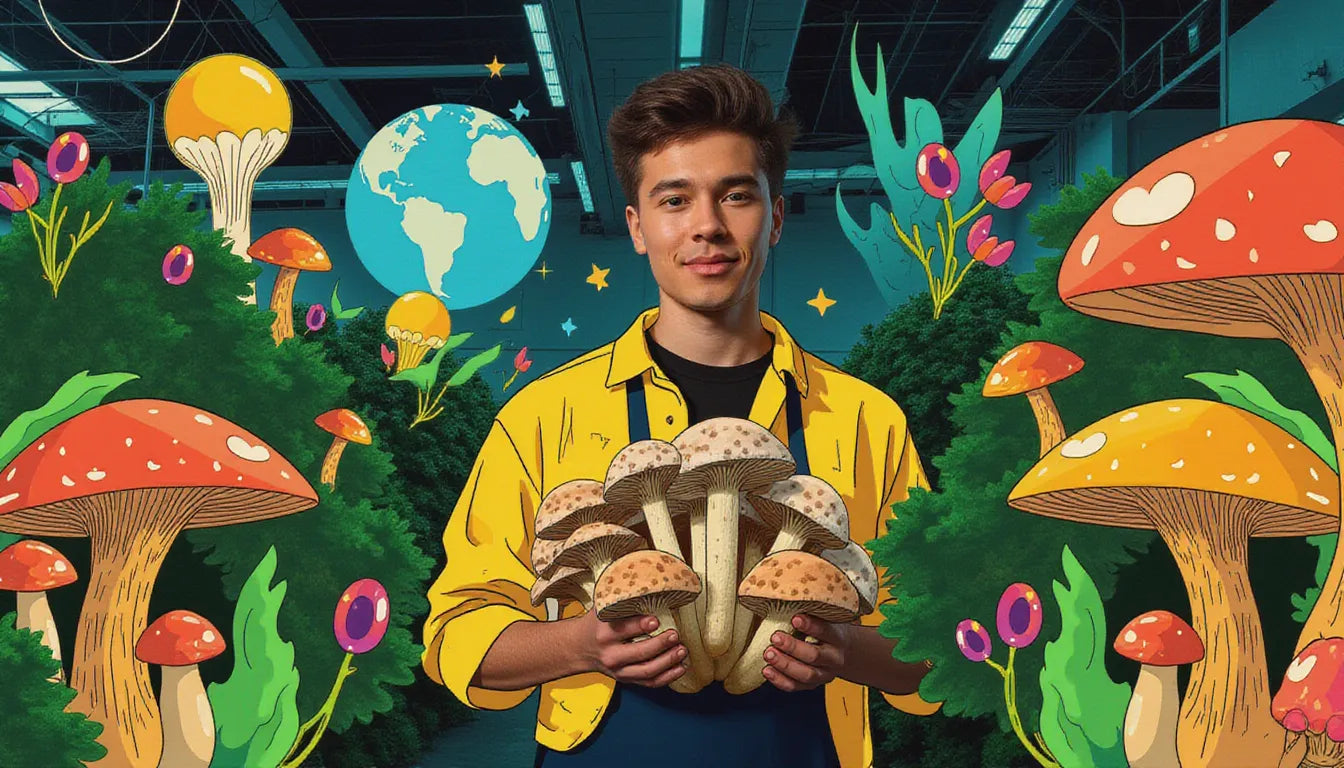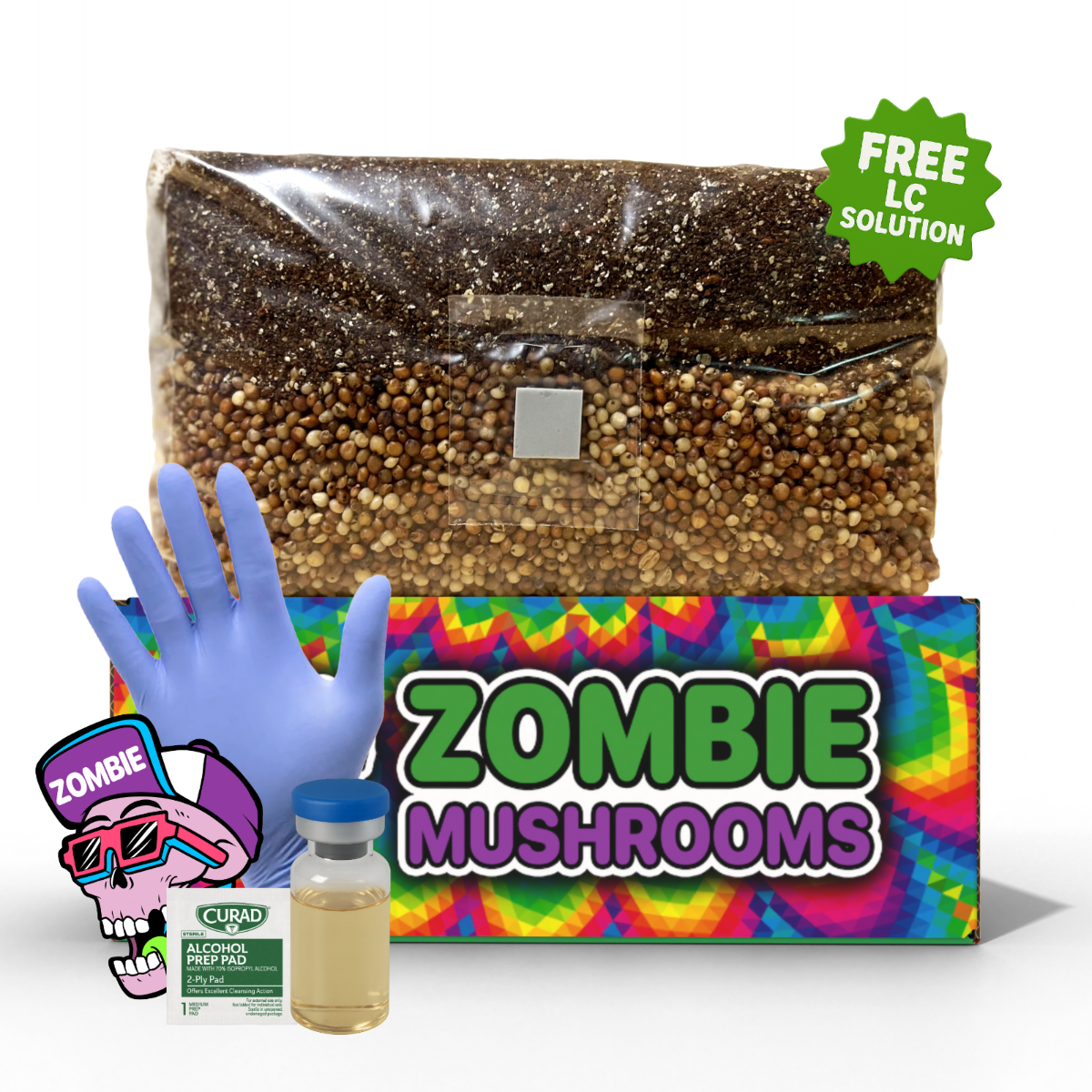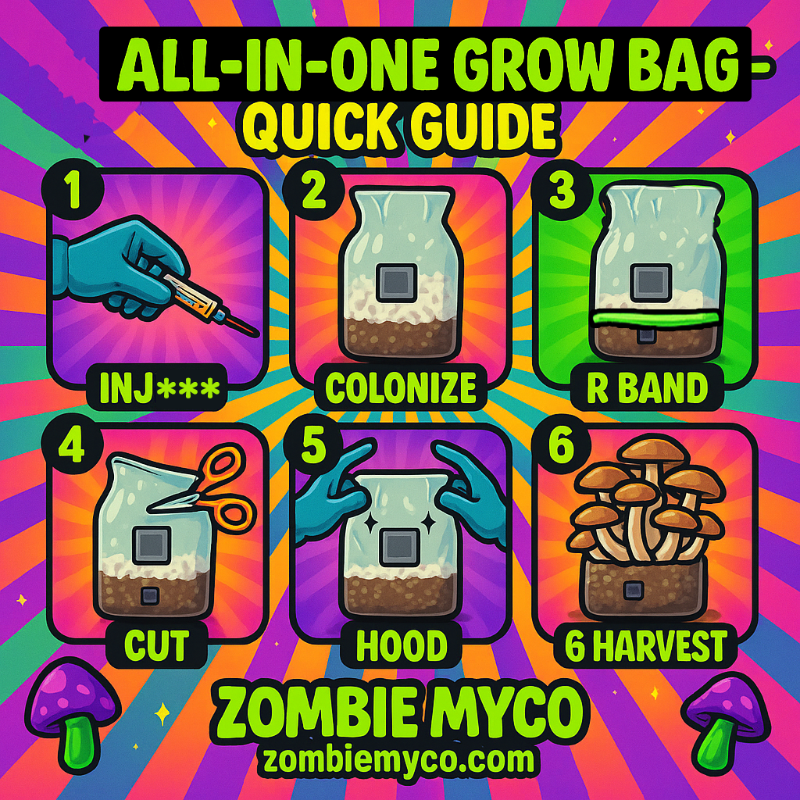⬇️ Prefer to listen instead? ⬇️
- Mushrooms produce just 2.13 kg CO2e per 1 kg, vs. 27 kg for beef.
- Mushroom cultivation uses 13 to 20L water per kg; almonds use 322L.
- Gourmet mushrooms grow on recycled waste like sawdust, corncobs, and coffee grounds.
- Mycelium improves soil health, stores carbon, and supports farming that heals the land.
- Urban farming models use mushrooms to turn city waste into sustainable food.
From shiitake and lion's mane to the delicate oyster mushroom, gourmet mushrooms are helping the sustainable farming movement. They grow fast, need few resources, and offer big benefits for the earth. This puts them in a key spot for food systems that last and work well, even with changing weather. So, how sustainable is growing mushrooms really—and can these fungi help build a greener tomorrow? Let's look closer at how gourmet mushrooms are good for the earth, and how tools like mushroom grow bags make small-scale cultivation even more eco-friendly.

The Environmental Benefits of Mushroom Cultivation
Growing mushrooms is just naturally efficient. Traditional farming often needs huge areas of land, lots of water, and big machines. But gourmet mushroom farms can work in small, controlled indoor spaces. These fungi do well in little setups inside—this includes spare rooms, garages, and city buildings not being used.
They also work well for vertical farming. Stacking shelves or racks lets growers get more mushrooms from each square foot. A medium-sized room with good moisture and temperature can make many pounds of fresh mushrooms every week. So, growing mushrooms is a good way forward in places where land is scarce and in cities looking for ways to grow food nearby.
A Year-Round Bounty
Mushrooms don't need sunlight and aren't affected by how much daylight there is each season. This means you can grow them indoors all year. This also means fewer problems from odd weather—like dry spells, storms, or really hot or cold times. It gives farmers and food suppliers a steady supply of mushrooms. For places having trouble with farming because of weather changes, mushrooms offer a tough solution.

Mushrooms and Their Surprisingly Low Carbon Footprint
When people look at how green something is, the carbon footprint is often a key measure. Luckily, gourmet mushrooms have a low carbon footprint. According to the Environmental Working Group, making one kilogram of mushrooms puts out just 2.13 kg of CO2e. This is much less than the emissions from meats like beef (27 kg CO2e per kg). It's also much lower than many vegetables.
How do mushrooms keep emissions so low?
- No tilling or machine soil prep: Mushroom farming doesn't need plowing or tractors.
- Small space needed: Less land gets messed up, and no forests need to be cut down.
- No fertilizers or pesticides: Mushrooms don’t need man-made chemicals. This avoids chemical runoff and the emissions that come with it.
Indoor mushroom farms don’t just cut down on emissions; they can also run inside buildings that are already there. Using an old garage or warehouse means less carbon cost from making and building new things. It also puts unused space to work.

Using Old Farm Waste as Mushroom Substrate
Mushrooms don't grow in soil. They grow on organic stuff that has been composted. This is called substrate. This substrate is often made from plant waste from farms like:
- Straw
- Sawdust
- Corncobs
- Coffee grounds
- Cottonseed hulls
- Paper waste
Instead of throwing these things away or letting them rot in landfills—where they can let off a lot of methane gas—mushroom growers give them a second chance. Fungi naturally break down parts of the plant matter, turning it into food or material for medicine.
This fits mushroom growing with the idea of a circular economy. In this system, waste is used as an input for something new, not just thrown away.
Also, used grains from breweries and distilleries make great material for growing mushrooms. This lets different industries work together to be more sustainable.

Water Efficiency in Fungi Farming
Not having enough water is a growing problem everywhere. This makes people look closely at how farming uses water. Luckily, mushrooms are very good with water use.
To make one kilogram of mushrooms, only 13 to 20 liters of water are needed. That’s very efficient compared to:
- Almonds: 322 liters
- Beef: over 15,000 liters
- Rice: 2,497 liters
Mushroom farming is efficient because of systems that reuse water. Mushrooms need just the right amount of moisture in the air. Growers often keep things moist by using water collected from the air in the grow room. Misting systems, foggers, and tanks that collect water help stop waste. They also cut down on how much outside water is needed.
For people growing mushrooms as a hobby or at home, a simple tent or small greenhouse that holds moisture can keep the right conditions using just a bucket of water each week.

Sustainability in Home Mushroom Growing
One great thing about growing mushrooms is how easy it is to do at home. With more DIY grow kits available, anyone can try growing gourmet mushrooms. This is true even in small apartments or basements with no windows.
Environmental Benefits of At-Home Cultivation
- Very local food: No need for transport, refrigeration, or long-term storage.
- Little packaging: Many kits come in containers that break down naturally or can be recycled.
- Turning waste into something useful: Homegrowers can use coffee grounds, paper, or yard trimmings as substrate.
Just one oyster mushroom grow block can give you several harvests. This provides weeks of fresh mushrooms full of protein. Once the harvests stop, the used substrate can be composted or put straight into garden beds to help the soil.
Growing food at home builds food sovereignty. This means people have direct say over some of their food supply. And it means they don't have to rely as much on big industrial farms.

The Potential of Mushrooms in Regenerative Agriculture
Regenerative agriculture tries to go beyond just being sustainable. It works to actively heal the environment. Mushrooms—and especially mycelium—are great helpers in this.
What Is Mycelium?
Mycelium is the huge network of thread-like parts (called hyphae) that grows under the mushroom cap. This fungal network connects with soil, plants, and trees. This helps with:
- Storing carbon: Keeping CO2 from the air in the soil.
- Fixing soil: Making tired or packed-down soil healthy again by breaking down organic stuff.
- Holding water: Helping soil hold more water in places that don't get much rain.
Mycelium networks send chemical signals to nearby plants. They can warn plants about dangers or give them nutrients. When fungi are used in farming systems that mimic nature, they can help keep ecosystems alive and make them stronger over time.
Fungi even help filter pollution. This makes them useful for cleaning up dirty land.
Energy Efficiency in Controlled Environments
People often point out that farming in controlled indoor places uses a lot of energy. Lighting is a big part of this. But growing mushrooms has a big plus: mushrooms don’t need sunlight.
Unlike plants like lettuce or tomatoes in vertical farms, mushrooms grow in the dark in cool, moist conditions. This means:
- Less need for electric lights (or none)
- No hot grow lights
- Less work for heating or cooling systems compared to growing plants
When energy is needed—for moving air or controlling moisture—heaters that use less power and efficient dehumidifiers can keep energy use low. Smart systems and timers help use power even better.
Even better: many indoor mushroom farms now use solar or other renewable energy sources. This means they barely produce emissions, or sometimes even help reduce them overall.

Case Study: Sustainable Urban Mushroom Farming
Cities around the world now have small mushroom farms. They grow in shipping containers, basements, rooftop greenhouses, and restaurant kitchens. These city farms often use circular economy ideas. They show how gourmet mushrooms can help the planet—and people in cities.
Features of Urban Mushroom Farms
- Using local waste: Coffee grounds from cafés become material for growing oyster mushrooms.
- Vertical farming: Growing upward makes lots of mushrooms in a small space.
- Community ties: City farms sell to farmers’ markets, co-ops, and local restaurants.
Urban mushroom farms turn food waste into crops you can eat. This means less waste in landfills, less pollution from transporting food, and fresh food where it might be hard to get otherwise.
Carbon Storing Potential through Fungiculture
Not many crops or animal farms can store carbon like mushrooms can. This is mostly because of how they work with the soil.
Fungi lock carbon in the ground in stable organic forms. As mushrooms break down plant stuff, most of the carbon stays in the ground instead of going back into the air. It turns into humus. Humus is nutrient-rich, full of carbon, and makes soil better and helps it hold water.
Also, mushrooms are very good at mycoremediation. This is a way fungi are used in dirty places to clean up things like heavy metals, oil, pesticides, or even plastics.
Key benefits of mycoremediation:
- Turns harmful things into safe ones
- Helps soil life come back
- Means less need for machines or chemicals to clean up

Social Sustainability: Community Connection Through Mushrooms
Sustainability isn’t just about nature—it’s about people and jobs, too. Growing mushrooms helps communities by making food easier to get, creating jobs, and teaching people about the environment.
From school programs teaching kids how to grow mycelium to urban co-ops helping local people start mushroom businesses, mushrooms are a hands-on way to be sustainable. Community mushroom gardens and places where people can grow them together often bring different age groups together. This helps people learn science by doing and encourages using food resources wisely.
Moreover, businesses focused on mushrooms often support small, varied businesses. This includes farms owned by Black people and growing groups started by refugees.

Eco-Friendly Cultivation Tips for Hobbyists and Small Growers
If you're trying out growing mushrooms at home or on a small scale, here’s how you can help the environment:
- Pick grow kits from nearby suppliers that use packaging that breaks down naturally.
- Reuse glass jars and kitchen containers for getting your mushroom spores started and for growing.
- Compost your used mushroom blocks or put them in garden beds.
- Try using paper logs or cardboard to grow on instead of getting new materials.
- Make a small mushroom "tent" with old plastic instead of buying new stuff.
These simple steps help keep your impact small and the natural world happy.

A Look Ahead: Where Gourmet Mushrooms Fit in the Future of Sustainable Food
The food of the future needs to be gentle on the planet. It also needs to be full of nutrients, taste good, and be easy to get. Gourmet mushrooms do all these things well.
They are now being used for more than just food. They are used for:
- Textiles made from mycelium ("leather" that breaks down naturally)
- Eco-friendly packaging to replace plastics
- Building materials that can help store carbon
- Compounds for medicine that help the brain and immune system
As people—like those who buy food, cooks, scientists, and people in cities—start using mushrooms more, their part in helping the planet, living in a way that heals the earth, and using resources wisely just gets bigger.
Cultivating Mushrooms – Helping the Planet
From city basements to farms in the countryside, growing gourmet mushrooms offers a sustainable way to feed people, help heal the earth, and make it stronger. They grow fast, produce few emissions, need little water, and help the land. This shows a clear example of how food can be good for the earth and also really satisfying.
With new ideas in packaging that is good for the earth, using fungi to clean up pollution, and growing food vertically, gourmet mushrooms are more than nature’s recyclers—they are a key part of the next farming revolution.
Whether you're growing shiitake in your shed, buying lion’s mane for dinner, or working with a local fungi farm, every step you take into mushroom growing is a step toward living in a way that helps the earth and makes things stronger for the future.



